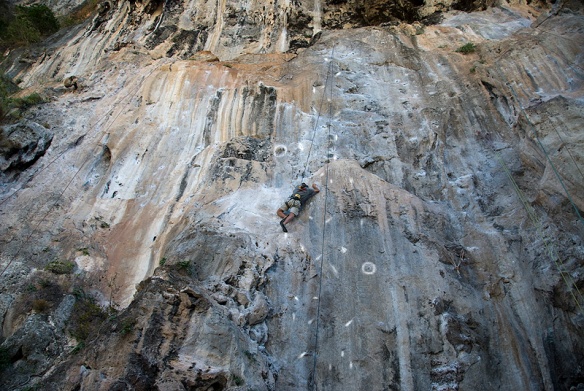There’s one question that many of my clients keep asking me: How did you climb that route so well? The answer is simple… I’ve climbed it about a hundred times! When we watch videos of Adam Ondra onsighting some ridiculous grade, like 5.14d, we’re not getting the whole story. It makes great video seeing a professional climber float up the wall, but the reality is, it may have taken Adam 20 times to finally learn the moves before he flashed the route. Sometimes this is done on top rope, on rappel, or even studying photographs of the route. This is called “projecting.”
Just last week, I was out at the cliff on one of my “projects.”
 As you can see, I am top roping the route. This is because lead climbing can be dangerous. Taking an unexpected fall can result in flipping upside down, or worse, getting the rope twisted around an ankle and snapping it. This is why most climbers will rehearse a route before taking to the sharp end, to minimize the risk of a fall. I have been working on this route for over a month. The first time I tried it, I was able to stick clip my way up to the anchors, and have left my rope on it ever since. This is so that when I get to the crag, my rope will always be on the route to save time. My first few times on the route, I would ascend the rope, working the moves out in my head. I made tick marks to help me remember and visually see where the small, yet crucial holds are. Each time I’m on the route, I try to perfect my movements, try different beta, move around my tick marks, and make mental notes. Practice makes perfect, and climbing is no exception.
As you can see, I am top roping the route. This is because lead climbing can be dangerous. Taking an unexpected fall can result in flipping upside down, or worse, getting the rope twisted around an ankle and snapping it. This is why most climbers will rehearse a route before taking to the sharp end, to minimize the risk of a fall. I have been working on this route for over a month. The first time I tried it, I was able to stick clip my way up to the anchors, and have left my rope on it ever since. This is so that when I get to the crag, my rope will always be on the route to save time. My first few times on the route, I would ascend the rope, working the moves out in my head. I made tick marks to help me remember and visually see where the small, yet crucial holds are. Each time I’m on the route, I try to perfect my movements, try different beta, move around my tick marks, and make mental notes. Practice makes perfect, and climbing is no exception.
I have probably top roped this route 40 times, and have got it down to only 2 falls. I know the areas I need to work on now, so it makes projecting so much easier. This is how I will send the route!
So what kind of climber are you? Do you try a route once, and if you fall, move on to another? Or do you invest the time to project, and one day go for the send? I challenge all of you to head to your local crags, and find a route that is out of your league. Next, throw a top rope on it, and just work out the moves. Take photos, make tick marks, and rehearse, rehearse, rehearse! It’s not glamorous, but this is climbing folks! If you want to get better, you have to put in the time.
Wesley




